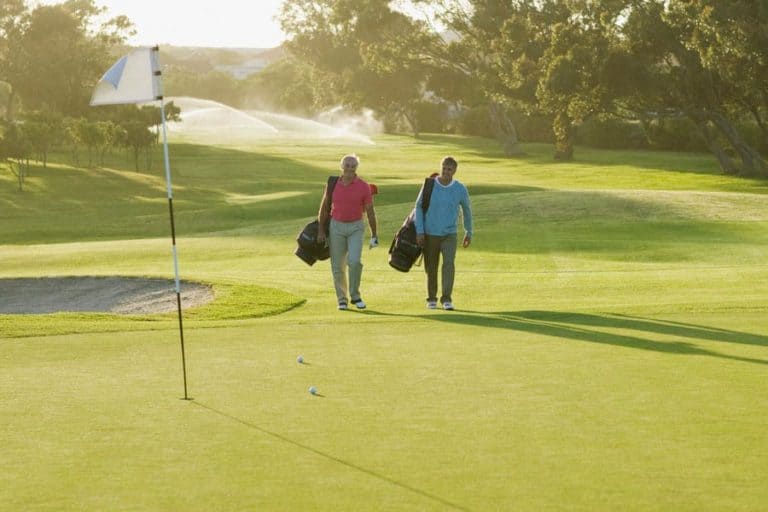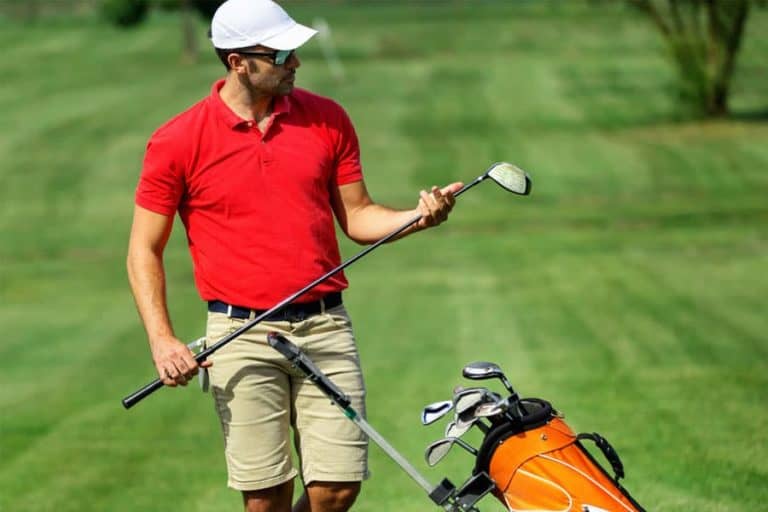How To Hit a Golf Ball Further: Step by Step Guide

Improve your golf swing and hit the ball further with tips on how to hit a golf ball further. These are suitable for an amateur to advanced player.
Do you want to hit your golf ball further? If you’re like most golfers, the answer is a resounding “yes!”
Different factors can affect your drive. However, there are a few simple ways to add extra yards to your shot. Listed below are factors that can decide how far your golf shot can travel.
How to hit a golf ball further: 11 important factors
There are certain factors that can improve your golf game. Some of the major factors have been discussed below:
1. Right club
Choosing the right club is essential if you’re trying to hit a long fairway shot. Generally speaking, the longer the club, the farther the ball travels. So if you’re looking to add some extra distance to your drive, try using a longer club such as a driver or 3-wood.
The driver loft and attack angle also make a huge difference. The swing speed decreases with the increase in the driver’s loft. However, the trade-off is that a higher-lofted driver will hit the ball in the air for a longer time, thus covering more distance.
Ideally, amateur golfers would benefit from using a driver with a higher loft angle (10 – 12 degrees), But on average, the driver has a 10.5 degrees loft angle.
2. Golf ball type
Golf balls are made of different materials, each of which has different compressibility levels. Some golf balls work better at higher speeds, while others don’t. The harder the ball, the further it will travel. Some materials used in golf balls are surlyn, balata, and urethane.
3. Club path and speed
You can add considerable distance to your golf shot by altering your delivery from a ‘fade’ to a ‘draw.’
Golfers who hit a fade typically have a clubface that is open relative to the target line at impact, while those who hit a draw have a clubface that is closed relative to the target line. Closed clubface results in shots with less spin, thereby carrying off to a longer distance.
Moreover, Many factors affect the speed of a club when hitting the ball. The club’s type, material, weight, and swing all play an essential role in how fast the ball will travel. In addition, the type of ball being used also affects speed. For example, a harder ball will travel further than a softer ball.
4. Swing speed and power
Having a fast swing speed will enable you to hit the ball further. How do you measure your swing speed and eventually improve it?
One way is by using a heavier golf club. The extra weight will help you generate more clubhead speed. Another way to increase your swing speed is by working on your flexibility. You can make a fuller turn and generate more clubhead speed if you’re more flexible.
A thumb rule is that a swing of 100 mph will drive your golf ball 250 yards. If you increase the swing speed to 110 mph, the drive will travel about 280 yards.
You can do a few key things to generate more power in your golf swing.
- The importance of a good grip cannot be overstated. A weak grip will result in a loss of power, while a strong grip will help you to transfer more energy to the ball.
- Second, keep your arms close to your body as you swing. This will help you to maintain your center of gravity and generate more torque.
- Finally, make sure you follow through with your swing. A good follow-through will ensure that all of your energy is transferred to the ball, resulting in a powerful shot.
5. Accuracy
Increasing the swing speed often results in a loss of accuracy.
How do you achieve both?
One way is to tee the ball up higher. A higher tee will help you make contact with the golf ball in the sweet spot. A higher impact location increases the club’s effective loft and produces a higher-launching golf shot with less spin.
Hitting the ball accurately reduces the backspin and side spin, making the ball fly more efficiently and straighter. This results in hitting the ball further.
6. Ball spin
One big reason for not being able to hit the ball very far is a high spin rate. A high spin rate will cause the ball to stall in the air, resulting in a shorter shot.
How do you reduce spin? Make sure you hit the sweet spot on the clubface. When you make contact with the sweet spot, it will compress the ball and reduce spin.
7. Grip and Posture
A proper grip on the club is essential for an ideal golf swing. How you hold the club will determine the angle of the clubface at impact. Make sure that your grip is not too tight, as it will result in a loss of clubhead speed.
To increase the speed of your club, start by ensuring that you are using the proper grip. A firm grip will help you to hit the ball with more force. Also, make sure you are using a club with the right size and weight.
Focus on your form and practice swinging with power. The more practice you get, the easier it will be to increase your speed and hit the ball farther.
Your posture also plays an important role in the distance your ball covers. How you position your body will affect your swing. Make sure that you have a good stance and balance. A proper golf posture will help you make a more consistent swing.
8. Arm position
Ensure that your lead arm is straight and not bent at the elbow. A bent elbow will result in a loss of power and shorter golf shots.
The straighter your arms, the longer the distance a golf ball travels. This is because a straight arm allows for a longer distance for the clubhead to travel before striking the ball. The longer swing results in more distance achieved on your shot.
The position of your arms also affects the clubface. If your arms are too close to your body, it will cause the clubface to open at impact. This will result in a fade or slice. If your arms are too far from your body, it will cause the clubface to close at impact. This will result in a draw.
9. Footwork
Perfect footwork is essential to gaining distance. Keep your feet firmly planted on the ground and transfer your weight from your back foot to your front foot as you make your golf swing. This will help you generate more power and hit the ball further.
In addition, make sure that your feet are parallel to the target line. This will help you make a more consistent swing and hit the ball straighter.
10. Flexibility of the golfer
A golfer needs strength and flexibility in his/her body to deliver a fairway shot. However, relaxed muscles move better than tense muscles. Being flexible helps you maintain a proper golf posture and make a consistent swing. It also enables you to generate more clubhead speed. Relax your wrists, legs, and torso as you make your golf swing.
Improving the strength of the muscles involved in the swing also increases the speed of your golf swing. Stronger muscles produce more force and power. Golfers who wish to improve their form and performance can try exercises like yoga and golf squats to improve their form and flexibility.
11. Tempo and follow through
A smooth swing is not all there is to a perfect fairway shot. The follow-through is just as important. After making contact with the golf ball, make sure that you complete your golf swing. Do not stop your swing midway, as it will result in a loss of power and a shorter shot.
The tempo of your golf swing also plays an important role in the distance your golf ball travels. A faster tempo will generate more clubhead speed and result in a longer golf shot.
However, make sure that you do not swing too fast, as it will affect your accuracy. Find a balance between speed and accuracy to hit the ball both far and straight.
A step-by-step guide to hitting a fairway shot
A good fairway shot starts with perfecting the basics of your ball strike. Improving your ball striking will improve your chances of making solid contact with the ball. This, in turn, improves your accuracy and distance.
Perfecting your stroke will also reduce the ball’s spin, improve your control, and add more power to your shots. Here is a step-by-step guide to hitting a golf ball straight and long:
Step 1
Address the ball correctly. You need to be in a comfortable position with the ball in the middle of your stance. Your feet should be shoulder-width apart, and your weight should be evenly distributed on both feet.
Note: Make sure that your feet are positioned perfectly. Having great footwork is really important to help gain distance. Place your feet shoulder-width apart and make sure that they are parallel to the target line.
Step 2
Focus on your grip and posture. A good grip will help you control the club, and a proper stance will ensure that you make solid contact with the ball. Focus on your arm position. Keep your wrists relaxed and your grip tight. Keeping your lead arm straight is essential for adding distance.
Step 3
As you take a stance, relax your muscles. This will increase your flexibility and allow you to get into the necessary backswing and downswing positions, maximizing swing speed at impact.
Step 4
Next comes the backswing. Start taking a position for the backswing. Move your club back using your arms and shoulders in a single coordinated movement. All this while your arms should be straight and your wrists ready for the movement that follows.
Step 5
Once you have completed the backswing, it’s time to focus on the downswing. The downswing is all about generating speed and power. Using your body weight, shift your weight from your back foot to your front foot. This will help you generate more power as your clubface makes contact with the ball.
How to hit the sweet spot more often?
Every golfer knows the feeling of hitting the sweet spot. The ball comes off the clubface with a perfect mix of speed and spin, sending it soaring down the fairway with pinpoint accuracy. It’s a feeling that every golfer craves, but one that can be surprisingly elusive.
Thankfully, there are a few things you can do to increase your chances of finding the sweet spot more often. Follow these tips to get that golf ball soaring straight to the fairway:
- Pay attention to your clubface angle at impact. If it’s open or closed, it will cause the ball to veer off course.
- Finally, focus on making contact with the ball at the center of the clubface. Hitting it too high or low on the face will reduce both distance and accuracy.
How to add distance without losing accuracy?
For many golfers, adding distance is a top priority. After all, being able to hit the ball further can give you a significant advantage on the course. However, simply trying to swing harder is not always the best solution. It can often lead to a loss of accuracy. So, how can you add distance without sacrificing accuracy?
One key element is ensuring you have a good grip on the club. A strong grip will give you more control over the club head. Another important factor is your stance. A wide stance will provide stability and help you to keep your balance during the swing.
Additionally, be sure to keep your weight centered over the balls of your feet. This will help you to maintain your balance and prevent you from losing power during the downswing. Finally, remember to follow through with your swing. A good follow-through is absolutely essential for accuracy.
Conclusion
To sum up, if you want to hit the golf ball further, you need to focus on your posture, grip, and club choice. By following the steps given above, you can develop a powerful and accurate swing that will help you hit the golf ball further than ever before. Practice makes perfect, so get out on the driving range and start working on your game today!








